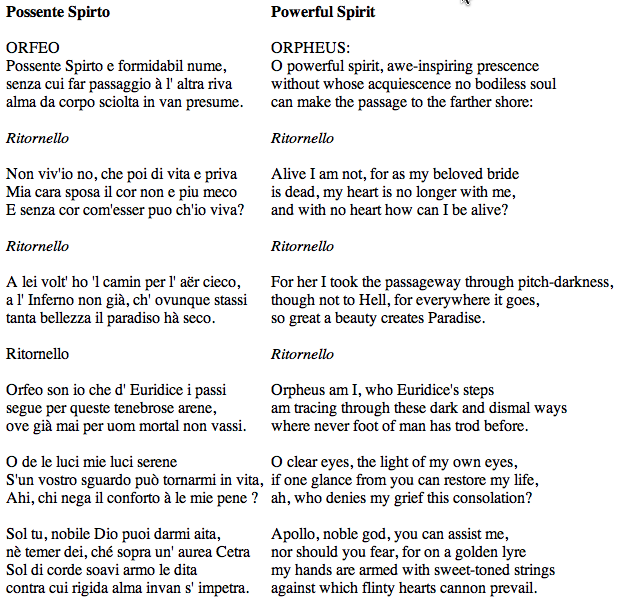.
Tells the story of Orpheus. Consider at this moment, the power of the orpheus legend with respect to sound and music.
L’Orfeo is considered to be the first opera, or at least, the first serious opera. Operas are commonly divided into arias, recitatives, and choruses.
1. Toccata
Listen to the Toccata that opens the Opera:
[audio:http://www.jaimeoliver.pe/snd/mh/orfeo/toccata.mp3]Q1.1 What is the spirit of the toccata and how does it relate to the cover of the score shown below?
(here is my translation…)
L’ORFEO
Fable in Music
by Claudio Monteverdi
Presented in Mantova
in the year 1607 & and again in …
To his Excellency Mr (Sir might be better…)
Don Francesco Gonzaga
Prince of Mantova, and Monserato
Printed in Venice by Ricciardo Amadino
MDCIX (1609)
Who is Gonzaga?
Where is Mantova?
Again, how does this text relate to the Tocatta?
Let’s now watch the production by Jordi Savall, at the Liceu in Barcelona:
Q.1.2 What do you think was the function of the Tocatta in the performance of L’Orfeo?
2. Prologo: La Musica
Look for a second at the beginning of the score for the Prologue.
Can you recognize the Basso Continuo?
Let’s pay attention to two important innovations:
- The Recitativo style
- The Ritornello Form
Let’s watch:
Try to follow the Libretto:
 Here is the audio in case you want to listen instead of seeing:
Here is the audio in case you want to listen instead of seeing:
[audio:http://www.jaimeoliver.pe/snd/mh/orfeo/prologo.mp3]
3. Aria: Possente Spirto
When listening to the excerpt below, have these questions in mind:
Q.3.1. How does the singing style of this aria compare to that of the recitativo? (for example, which one is more melismatic?)
Q.3.2. Why do you think he chooses to use this singing style for this aria?
[audio:http://www.jaimeoliver.pe/snd/mh/orfeo/Possente.mp3]The following clip gives some context to Orfeo and to the stage design for the Savall production. Watch as much as you can, but try to each at least the first few minutes.


